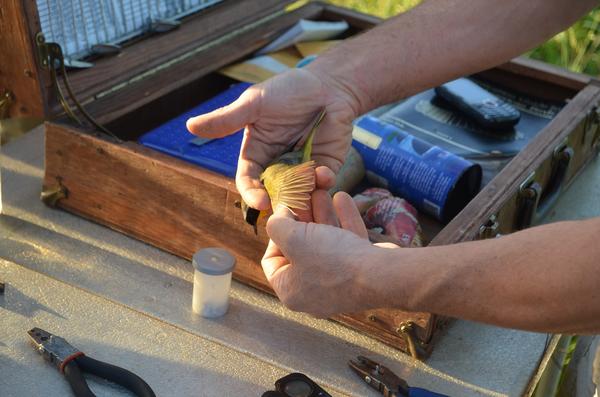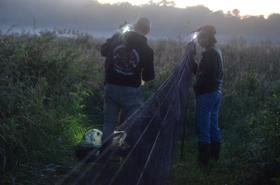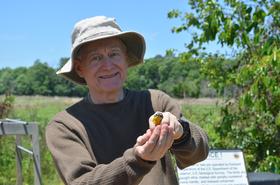Banding Atlanta’s Birds Offers Glimpse Of Their Lives

It’s the time of year when baby birds start to leave their nests. A research project south of Atlanta is revealing more about the birds that nest here by catching them.
Just after dawn on what will be a sunny, late-spring day, Charlie Muise is standing at a fold-out card table, set up on a dirt road. He’s in a damp, dewy meadow at Panola Mountain State Park in southern DeKalb County at his bird banding station.
A volunteer brings him a little drawstring cotton bag that’s twitching. He sticks his hand in.
“It’s very jumpy, this feels like a wren,” Muise says. “It’s always fun to try to guess what species is in the bag. It’s a little game we play here.”

He pulls out a little brown bird that fits easily in his palm. He guessed right; it’s a Carolina wren. And he’s caught this particular bird before.
“So this is a recapture,” Muise says. “The first thing you need is the band number.”
This wren already has a tiny metal bracelet around its leg, identifying it. Muise dictates information to a volunteer to take down: age, sex, weight and what shape the wren’s feathers are in.
Muise has been banding birds in this meadow at Panola Mountain for eight years. He has a contract with the Georgia Department of Natural Resources to do this research.
“We’re learning things like site fidelity. Are migratory birds coming back to the same area year after year?” he says. “We’re learning productivity, how many young are they producing, we’re learning survivability, how long do those birds live?”
He’s also learning when migrating birds get here, when they nest and when they leave.
“The purpose for the station is to monitor the change in bird populations over time as folks with the state parks and the non-game division of DNR are restoring the area,” he says.
This area used to be a field for cattle grazing. Since the early 2000s, the state has been planting native grasses and flowers in the park, with the goal of making it more like the kind of open meadow that would have existed before Europeans settled in Georgia. As the state has restored the land, Muise says he’s seen changes in the bird population.
“We’ve got a long way to go, and yet we’re seeing increased site fidelity, increased longevity, increases in species we’re looking for,” Muise says.
One thing he’s learned from banding birds at this 120-acre meadow and at another, smaller area is that the birds prefer a much bigger open space, even if it’s not perfectly restored. It’s like choosing an older house instead of a pristine studio apartment.
“If we have like a six-acre patch of land, and we made it into absolutely perfect habitat, honestly we wouldn’t be helping a whole lot of species, and we wouldn’t be helping most of those species a whole lot,” he says.

Muise and his group of volunteers catch the birds by erecting big, black nylon nets around the meadow. They’re like extra-long volleyball nets with super-thin string. The birds don’t see them when they’re flying around. The banders walk back and forth between the nets all morning so the birds don’t get stuck for too long.
One of the regular volunteers is Anne Armstrong. She lives in Macon and drives to the park before sunrise two Saturdays a month. She says it’s worth it because she likes to contribute to conservation.
“And just the wonder of being out in these fields that are just teeming with life,” Armstrong says.
She finds a little yellow and olive green bird in a net.
“Common yellowthroat,” she identifies it as it squeaks at her.
“The yellowthroats are the ones you hear that go singing witchety, witchety, witchety,” Armstrong says, laughing. “They can be kind of tricky to extract because they’re so tiny.”

She has a hook, a kind used by knitters, to help free the bird from the nylon strands of the net.
“You can’t get in a hurry, and you can’t flinch because the safety of the birds always comes first,” she says.
She takes the bird back to the banding station, so Muise can get its stats.
“We catch lots of yellowthroats,” Muise says.
Around Atlanta, common yellowthroats aren’t hard to find. Muise says even though serious birders might not get excited about them, they’re important for this research.
“From a scientific point of view, there’s little value in a rare species,” he says. “We get all excited, ‘Ooh I’ve only handled two of these ever,’ that sort of thing. But what’s really valuable, from a scientific point of view and from a conservation point of view, are these things we catch lots of all the time.”
He says it makes sense to watch the common birds because if something started to happen, and one of those species started running into trouble, he might see the signs before the bird reached the brink of extinction.
“Watching what’s happening to birds now before they get almost to the end is just the sensible way to do things,” Muise says.
He gets all the information he needs from the yellowthroat, opens his palm and lets it get back to its morning.
“Don’t come back today,” he calls to it. “Come back as many times as you want, but just once a day please.”
Muise and the banding volunteers are out at Panola Mountain every other Saturday, all year long. The state is still working on restoring the meadow, one of the first projects of its kind in North Georgia.
9(MDAxODM0MDY4MDEyMTY4NDA3MzI3YjkzMw004))






